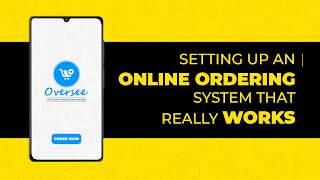SETTING UP AN ONLINE ORDERING SYSTEM THAT REALLY WORKS
Online food ordering is picking up pace as more and more people are looking for taste within their own premises. The demand is not going to abate soon. A study indicated that at least 70% of Americans preferred online food deliveries. At this rate, by 2025, the market is expected to overshoot $200 billion. Online ordering systems are now imperative if restaurant owners wish to get a piece of their market share. While this is visibly an additional revenue stream for your restaurant, you are ideally playing against a highly competitive marketplace.
Here are some approaches analysed by experts at OVERSEE POS. Along with these come both the pros and cons for each of them.
Using your website to create an in-house ordering platform
Utilising your website would mean you may have to first one if you don’t have already and then accept your client’s orders through the website. A website building platform or a CMS will be required, after which customers can go to the URL to place the order. Thereafter you get to manage the pickups, orders, and payments. The set-up is rather basic, and customers can only place orders and pay for the same. You can also scale to an online order processing app as you expand, for a small monthly fee.
The approach has its pros such as complete control of the entire online ordering process. Every aspect of the restaurant’s menu, pick up, and deliveries, are supervised by you. Besides, you also get direct access to all customer data that entered your website, which in turn provides you with an insight into the customers’ preferences. It comes with the ability to drive your marketing efforts, such as launching loyalty programs and offering discounts.
On the other side of the coin, you will have to invest in additional costs for maintenance even if the control in its entirety is with you. The burden of management also passes on to you. Some technical challenges will require professional advice, which you cannot fix in-house. Marketing outreach is also limited because you are not organic in your approach and your customer base remains stagnant.
The standalone platform for online ordering
There are several apps available online that will simply let you register and deliver food to your customers. These online third-party apps are standard, and while you don’t have total control, the logistics will be provided by the apps, to deliver food. The requirements, however, may vary according to the third-party app. You may have to furnish some basic information such as your business address, name, number, email and dishes menu. Onboarding instructions will then be provided by the personnel so that your account is activated and you begin receiving orders.
If the third-party app is popular, you may gain access to a large customer database and actively start booking orders. Since the deliveries are managed by the providers, you can forego the expenses of hiring vehicles drivers. Additionally, you can avoid overlooking every aspect of the order and delivery. Even if this seems like a fairly successful service, the commissions range anywhere between 15 to 35% for each sale. This means you lose a big chunk of your profits just by paying the middlemen. Besides, there is no guarantee that you will access the entire customer database making marketing and promotion a challenge.
The best way to go about it is by integrating the online platform with a POS
OVERSEE POS system easily integrates with any third-party or in-house ordering platform where you instantly begin receiving orders. These are automatically forwarded to you for your execution. This approach can streamline your ordering process without you having to juggle large volumes of orders, which are also channelised through the POS system. Thus, online ordering is automated and invites with minimal errors and hassles.
Reach out to us today without any delay to create a modernised combination of speed and accuracy across your restaurant operations.




Comments
Post a Comment